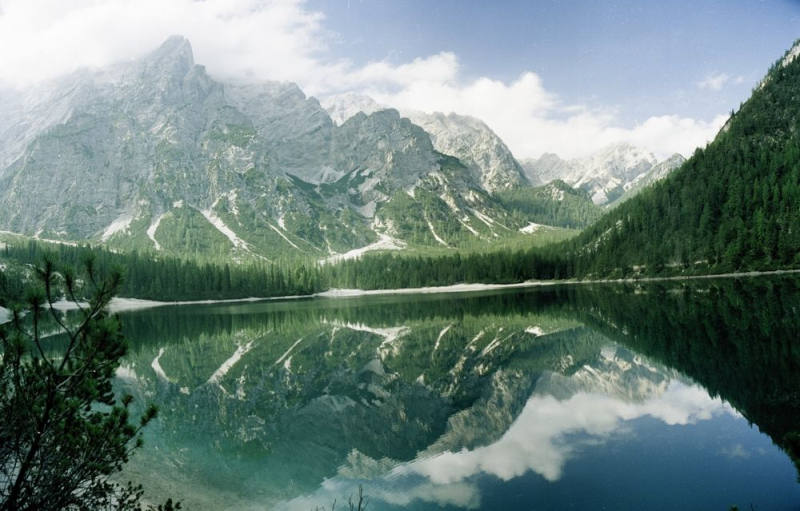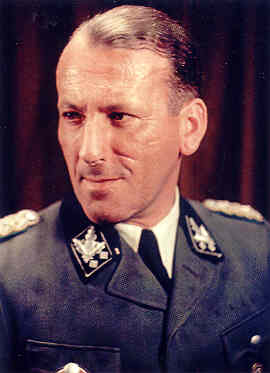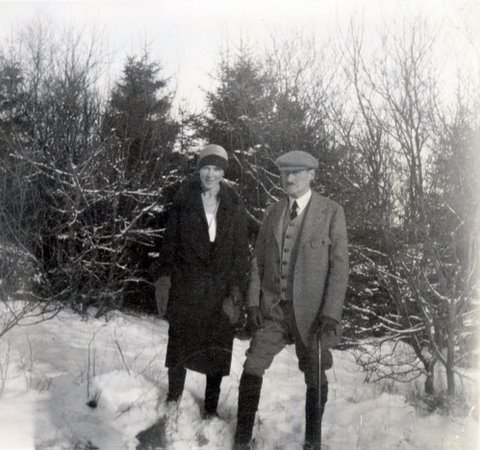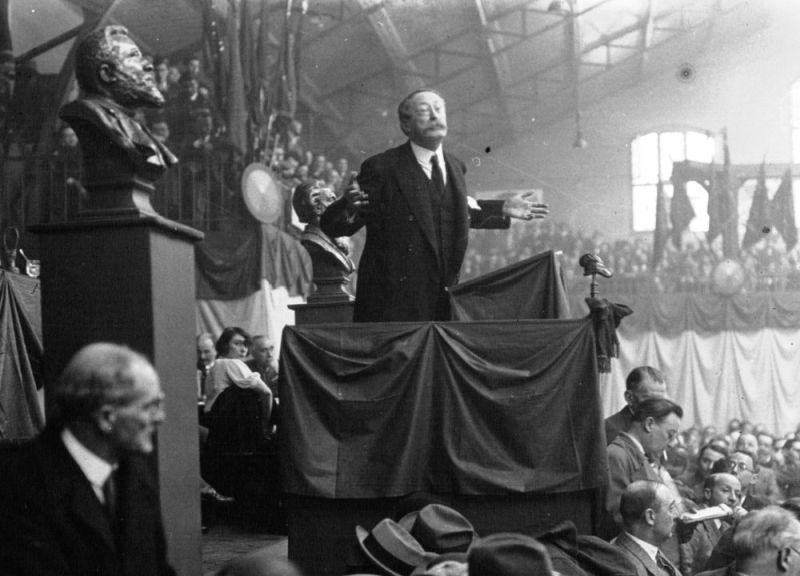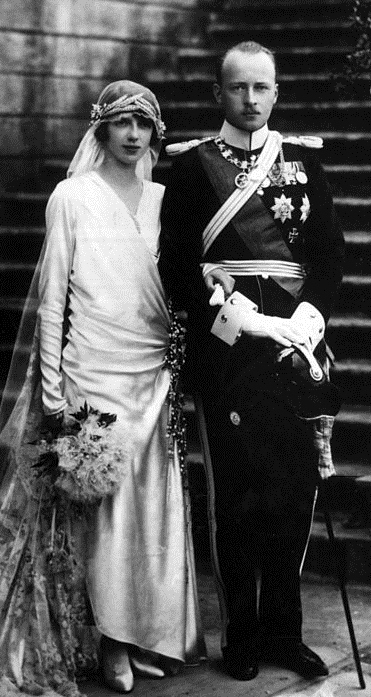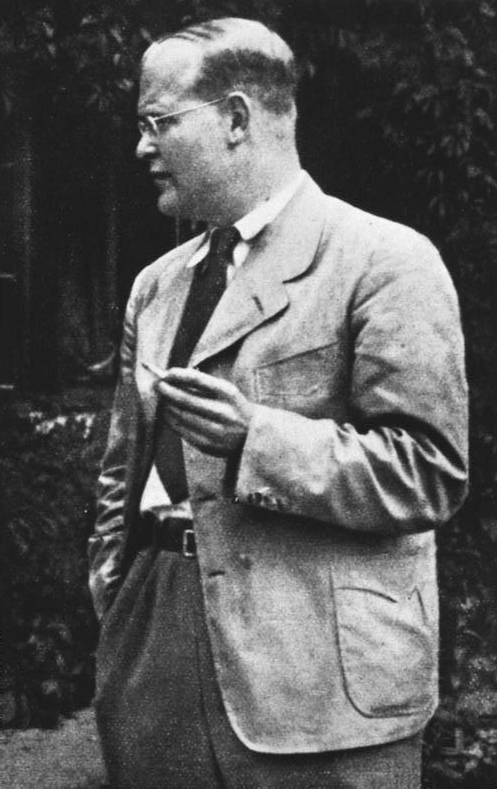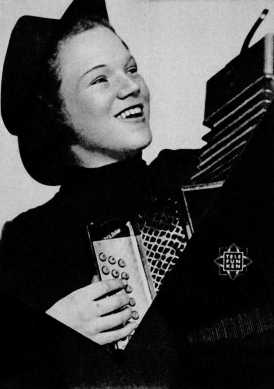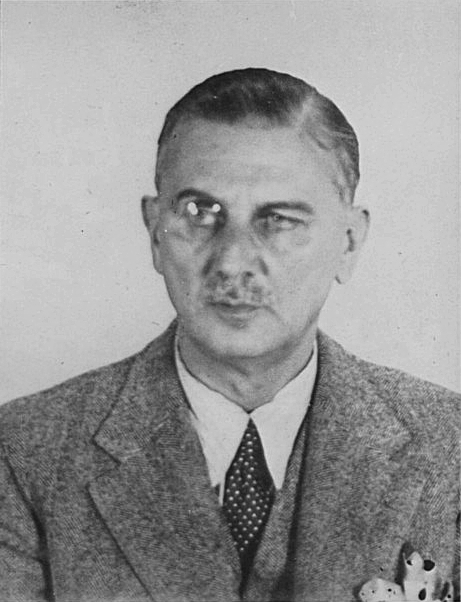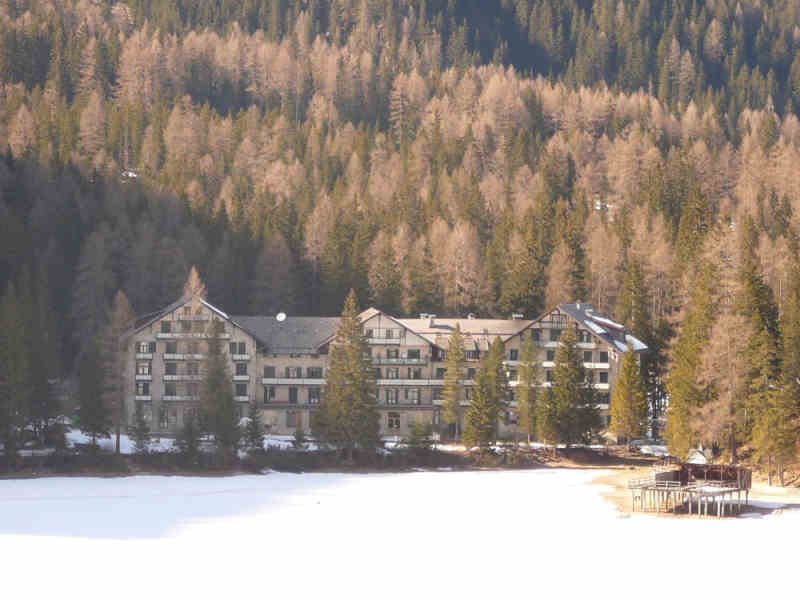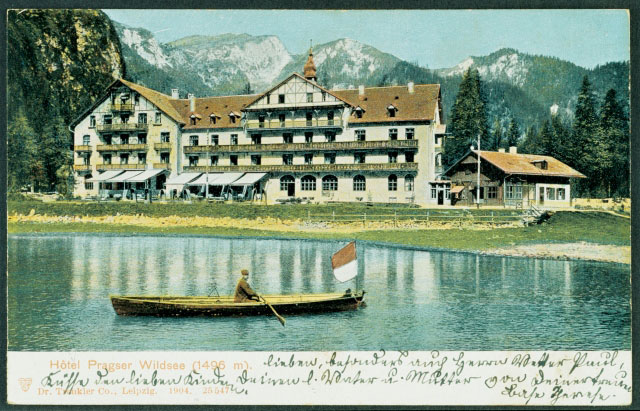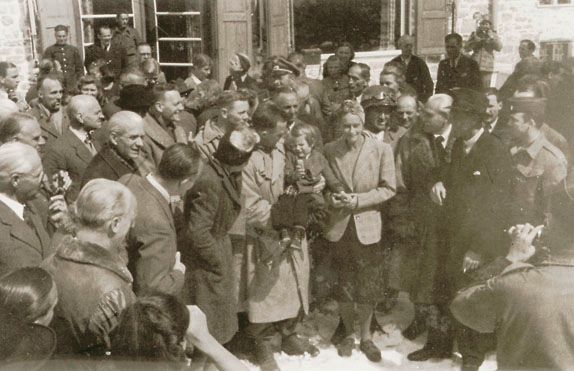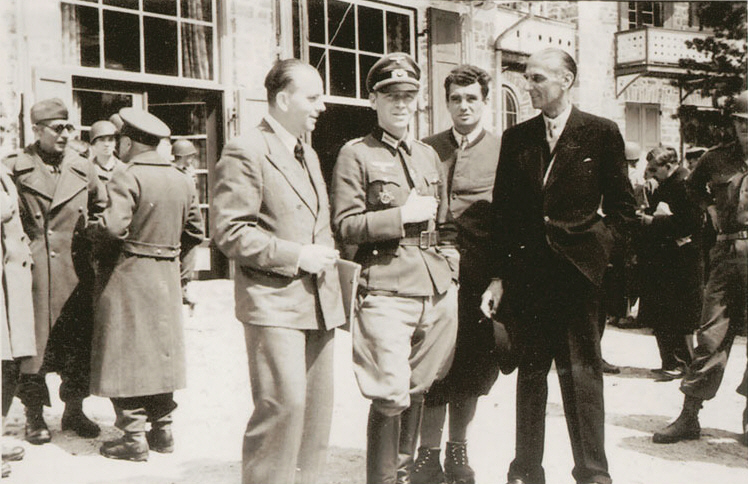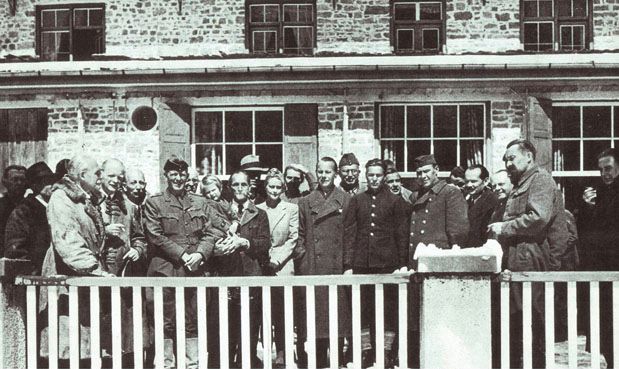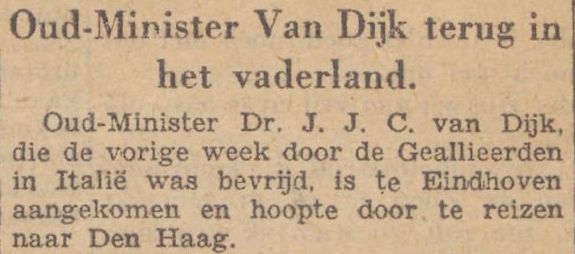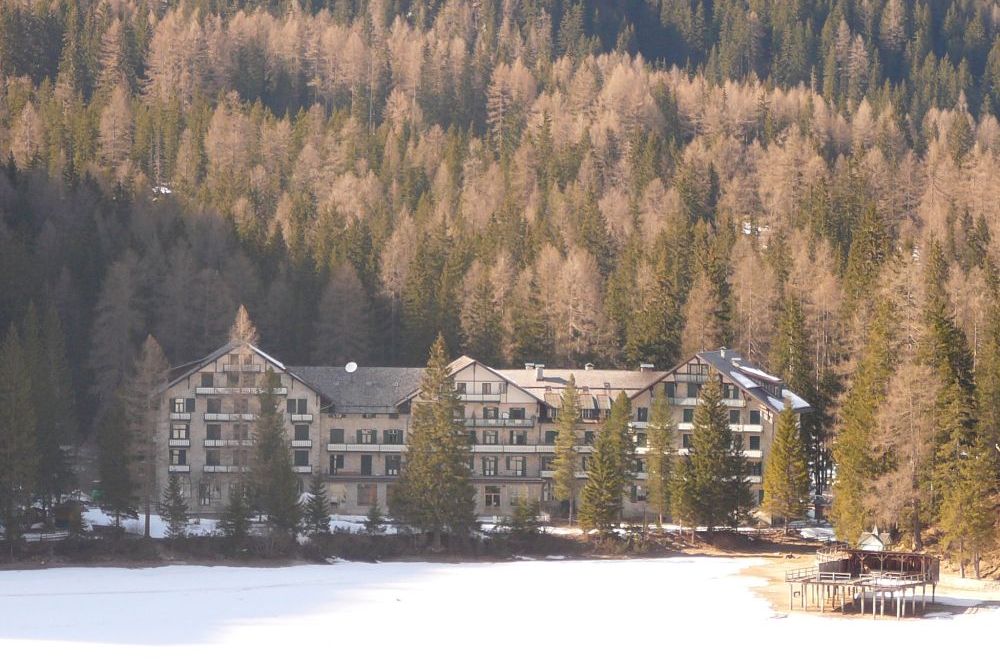Previous history
Introduction
It was a distinguished company that was assembled early May 1945 in Hotel Pragser Wildsee, built in chalet style, in southern Tirol, Italy. The group consisted of nearly 140 persons of 17 different nationalities. There were secretaries, high ranking clergy, generals and princes. Two Churchills were also present. From their hotel room they looked out on an emerald green mountain lake, ringed by fir trees and mountain tops. One of the hotel guests described the location as a " paradise on earth". For many of them, it was the first time in months or even years they had slept in a normal bed without having to worry about tomorrow’s day. At last, they had escaped from the claws of the SS.
Alpenfestung
Southern Tirol was a part of the Alpenfestung (Alpine fortress), the last pocket of Nazi resistance in the Alpine region. The intention was that a hodge podge of Nazi units would wage a guerilla war against the Allies from fortifications in the Alps, leading to an armistice on the western front. The western Allies would then have to join the German struggle against the Soviet ally. To the Allied Commander-in-Chief Dwight Eisenhower (Bio Eisenhower), a struggle against unyielding Nazi guerillas was such a nightmare, he left the conquest of Berlin to the Red Army while he dispatched his own troops in the direction of the Alps.
The war of attrition Eisenhower had feared so much did not materialize but that did not mean the Alpenfestung was no more than a myth. As early as the summer of 1944, SS chief Heinrich Himmler (Bio Himmler) had sent geologists to the Alpine region in order to search for suitable locations for fortifications. There was however no mass transfer of German troops to the south yet. The Werewolf units, resistance groups tasked with raising terror behind the Allied lines were also far more dominant in propaganda than in reality.
Hostages
An important advocate of the Alpenfestung was SS-Obergruppenführer Ernst Kaltenbrunner (Bio Kaltenbrunner). He was appointed chief of the Reichssicherheitshauptamt (R.S.H.A., Head Office of State Security) in January 1943 after his predecessor Reinhard Heydrich (Bio Heydrich) had died after an attempt on his life. Along with his boss, SS leader Heinrich Himmler, he imagined having an important trump card up his sleeve to draw the western Allies to the conference table in the final weeks of the Third Reich. Dozens of prominent foreign prisoners were dispersed all over the country in camps and on special locations. By using them as a means of exchange, the SS leadership hoped to have a foot in the door to be accepted as partners in future negotiations.
In the spring of 1945, Kaltenbrunner ordered the majority of the prominent prisoners or Sonderhäftlinge to be transferred to the Alpenfestung as hostages. The same applied to Sippenhäftlinge, relatives of those involved in the attempted coup of July 20th, 1944 (Assault 20-07-1944), among them relatives of Claus Schenk Graf von Stauffenberg (Bio Von Stauffenberg), the perpetrator of the attempt and former mayor Carl Friedrich Goerdeler who would have become Prime Minister, had the attempt succeeded. Via his adjutant Wilhelm Höttl, Kaltenbrunner attempted to negotiate with Allen Welsh Dulles, the future head of the C.I.A. who was stationed in Bern, Switzerland as agent of the Office of Strategic Services (O.S.S.), the American secret military intelligence service. He rejected any contact with the SS though. As a result, an insecure fate awaited the hostages.
Definitielijst
- Alpenfestung
- Fortification in the Alps. The first development spotted by the Americans in 1944. The Americans feared a stronghold in the Alps as a last resort of the Nazis. The plan was covered in mystery. On the one hand the Alpenfestung might be the last SS stronghold which could lead to defeat of the Allied forces. Enormous arms depots were built and Nazi elite troops would be able to hide everywhere in the Alps and cause death and despair behind enemy lines, sometimes even in allied uniforms. This terrifying development was fed by German propaganda trying to lure the American forces towards the Alps and away from the Rhine. Although the British warned against this, the Americans decided to divide their forces and had them advance towards Berlin as well as the south. The Alpenfestung turned out, however, to be nothing but a spectre.
- Nazi
- Abbreviation of a national socialist.
- propaganda
- Often misleading information used to gain support among supporters or to gain support. Often used to accomplish ideas and political goals.
- Red Army
- Army of the Soviet Union.
- resistance
- Resistance against the enemy. Often also with armed resources.
Images
Assembling in Dachau
Long and scary journey
A long and arduous journey preceded the transfer to the Alps of most of the prominent hostages. For Fey von Hassell, daughter of member of the resistance Ulrich von Hassell and other Sippenhäftlinge, their journey began in November 1944 when they were moved from various prisons and concentration camps to Hotel Hindenburg-Baude near Reinerz in Lower-Silesia. At the time, there were no plans yet to transport them to the south and their journey continued in northerly direction on November 30. Their destination was Stutthof concentration camp near Danzig on the Baltic Sea. They would remain there for approximately two months until they were evacuated at the end of January 1945 because of the approaching Red Army in order to prevent them from falling in Soviet hands. Via various intermediate stops they finally reached Buchenwald concentration camp near Weimar.
To Fey von Hassell, being moved from camp to camp was nerve wrecking. En route, she had been informed her father had been executed in September 1944 after he had been sentenced to death by the Volksgerichtshof (People’s Court). She knew nothing about the fate of her two little sons. She would be reunited with them after the war.
At the same time the Sippenhäftlinge arrived in Buchenwald, eight Sonderhäftlinge from Hungary arrived as well. among them Secretary of Internal Affairs Péter Schell. From as early as 1943, the French former prime minister Léon Blum and his wife Jeanne had been kept in complete isolation in a falconer’s cottage in the camp. On February 7, 1945, various Sonderhäftlinge were transported from Berlin to Buchenwald, among them the Russian lieutenant Vasily Vasilyevich Kokorin. The only reason he was considered a Sonderhäftling was that he was a cousin of the influential Soviet politician and Secretary of Foreign Affairs Vyacheslav M. Molotov (Bio Molotov), who had signed the non-aggression pact with Nazi Secretary Joachim van Ribbentrop in 1939. Theologian and resistance man Dietrich Bonhoeffer was deported from Berlin to Buchenwald as well.
Prominent prisoners in Flossenbürg
Some eight other prominent prisoners were deported from Gestapo headquarters on 8 Prinz Albrechtstrasse in Berlin and Sachsenhausen concentration camp to Flossenburg concentration camp. Among them a number of persons suspected of involvement in the July conspiracy like former Secretary of Economic Affairs and former president of the Reichsbank Hjalmar Schacht and the former chief of the general staff of the Wehrmacht, Generaloberst Franz Halder. Kurt Schuschnigg, Federal Chancellor of Austria between 1934 and 1938 also belonged to this group. British Lieutenant-colonel Jack Churchill and Captain Peter Churchill were also interned in Flossenburg as they were – incorrectly – considered relatives of British Prime Minister Winston Churchill.
After a stay of a few weeks in the camp, all prominent prisoners were taken to Dachau in three groups on April 8, 9 and 15 1945. Among them also Prince Philip von Hesse, a cousin of the former German Emperor Wilhelm II and a great-grandson of Queen Victoria of the United Kingdom. This close friend of Nazi star Hermann Göring (Bio Göring) was the husband of Princess Mafalda, the daughter of the King of Italy. After the fall of Italian dictator Benito Mussolini (Bio Mussolini), he had been arrested on charges of complicity. Princess Mafalda was injured in a bombing attack on Buchenwald, August 24, 1944, and had died the next day after a sloppy amputation of her left arm.
To Dachau
The prominent prisoners in Buchenwald were also moved farther south. That occurred on April 3 in two coaches for the Sippenhäftlinge, a prison van for the prominent prisoners and a private car for the Blum couple. The first stop of the convoy was Flossenburg but the prisoners were not admitted by the camp commander as the camp was overcrowded. The journey continued via Regensburg to Schònberg in the Bavarian Forest and arrived April 6. Here the prisoners were given food by the local population behind the backs of the SS. It also was here that the Gestapo took two prisoners away from the group: Dietrich Bonhoeffer and General der Artillerie Friedrich von Rabenau. Both men were suspected of complicity in the July conspiracy; they were taken to Flossenburg and executed the same month. The remaining prisoners in the transport reached Dachau on April 16 and 17.
Definitielijst
- Buchenwald
- Concentration camp established in 1937 near the city of Weimar.
- concentration camp
- Closed camp where people are being held captive that are considered to be anti- social, enemies of the state, criminal or unwanted individuals. These groups mostly do not get a fair trial or are condemned to doing time in a camp.
- Nazi
- Abbreviation of a national socialist.
- non-aggression pact
- Agreement wherein parties pledge not to attack each other.
- Red Army
- Army of the Soviet Union.
- resistance
- Resistance against the enemy. Often also with armed resources.
- Wehrmacht
- German armed military forces, divided in ground forces, air force and navy.
Images
From Dachau to Niederdorf
A mixed company
The 98 Sonderhäftlinge and the 37 Sippenhäftlinge of 17 nationalities who assembled in Dachau at the end of April 1945 were a mixed batch. Apart from Prince Philip von Hesse mentioned earlier the company consisted of other royals, such as Prince Xavier de Bourbon, brother of Empress Zita, wife of Emperor Karl I of Austria. The military men mentioned earlier had the company of the Greek Commander-in-Chief Alexandros Papagos and his general staff who had been deported to concentration camp Dachau in July 1943. Apart from Kokorin, there were five other military men, including general of the N.K.V.D. Ivan Georgievich Bessonov who, as prisoner-of-war of the Germans, had been co responsible for the failed Gulag operation. In connection with this operation, Soviet prisoners-of-war, secretly trained by the Germans, were to attack Gulag camps in Siberia and recruit prisoners for the fight against the Red Army.
The hostages left Dachau in three separate transports, April 17, 24 and 26. SS-Obersturmführer Edgar Stiller was in charge of the transport. 30 guards from Dachau and an SS-Sonderkommando of 20 men, commanded by SS-Untersturmführer Ernst Bader guarded the hostages. They were transported to Arbeitserziehungslager Reichenau (labor training camp), some 125 miles to the south near Innsbruck in overcrowded trucks. In the camp, conditions were bad, the barracks were rife with lice and the toilets were open trenches.
Boulevard of Broken Dreams
As Stiller did not consider filthy camp Reichenau a suitable place for the prisoners entrusted to him, he asked the Gauleitung in Innsbruck for a better location. Hotel Pragser Wildsee near Niederdorf/Villabassa in the Hochpustertal/Alta Posteria in South-Tirol was chosen as the new quarters. In this part of Italy, the majority of the population speaks German. In the evening of April 27, the prisoners left for their new destination in five coaches. The hostages were not informed about their destination and they feared what was going to happen. In order to keep up the good spirit, songs were sung in one of the coaches. The British prisoners and the popular Berlin comedienne and accordionist Isa Vermehren were among the passengers. After her brother, agent of the Abwehr Erich Vermehren and his wife had defected to the British in Istanbul on January 27, 1944, Isa and her parents had been taken into Sippenhaft. On the top of the Brenner pass, Isa and the other passengers sang the melancholic musical hit Broken Dreams from Moulin Rouge at the top of their voices.
The next day in pouring rain, the convoy arrived in Niederdorf. The hostages were taken out of the busses and could finally stretch their legs. Their arrival in the village did not go unnoticed. Therese Wassermannn, daughter of the pastry baker, wrote in her diary that at home we were startled by the sound of a large number of people passing by. "First, the children came, then armed soldiers, then civilians with women, again soldiers, high ranking military men in strange uniforms and again German soldiers among them. Many of these people looked weak and tired but there were also some with a proud posture, their heads held high and laughing. It was frightful".
Hospitable villagers
Meanwhile, there seemed to be a problem: Hotel Pragser Wildsee turned out to be occupied by the Wehrmacht. This meant shelter had to be found elsewhere for the hostages. The hospitable inhabitants of the village saved the day as both private persons and inn keepers were willing to receive them. A large group spent the night in the town hall sleeping on straw mattresses. The clergy were housed in the rectory. The villagers also provided food for their unexpected guests.
The SS took up residence in Hotel Bachmann on the village square. The guards drank heavily; making the situation even worse for the prisoners. In particular the presence of SS-Untersturmführer Bader caused great anxiety. Although he held a lower rank than Stiller, he had more authority. It was rumored he had been in command of a murder squad of the Gestapo. "A real prototype and a role model of his race", as Isa Vermehren later said about the Nazi. "The expression on his face was unpleasant, you saw the inflexibility he emanated could be deadly."
There were however more indications that seriously bothered the hostages. Some of them had witnessed a crate filled with grenades being loaded onto one of the busses. German hostage Oberst Bogislav von Bonin, who had been arrested in January 1945 for disobeying an order by the Führer had heard the SS whisper about a bomb underneath the bus. According to another rumor, the hostages were to be executed and their bodies subsequently be taken to the hotel and the building set on fire. Stiller is said to have confessed later he had indeed been ordered to liquidate his prisoners on the 29th to prevent them from falling in Allied hands. As hostages, they had no longer any value as it had become clear the Allies were not willing to negotiate and would only accept German defeat on all fronts.
Liberated by the Wehrmacht
The next day it transpired the hostages had little to fear from Stiller. During a meeting in Hotel Bachmann, he voluntarily handed over command of the transport to the prisoner’s committee, established by British Sigismund Payne Best. This S.I.S. agent had been arrested by the Germans as early as November 9, 1939 during the Venlo incident, along with his companion Richard Stevens, as they walked into a trap set up by the SS. Since then, both men were imprisoned in Sachenhausen and had been added to the group of hostages in Dachau. It was Best who emerged as unofficial spokesman of the hostages for his fluency in German and his fatherly nature.
In addition to Best, German Oberst Von Bonin played an important role in the events of April 29. That day he succeeded in calling for help by phone from General Hans Röttiger, chief of staff of Heeresgruppe C in Bolzano. Hauptmann Wichard von Alvensleben was dispatched to Niederdorf from Moos, some 12.5 miles east of Niederdorf and he arrived the same night. He considered the situation the hostages found themselves in sufficiently threatening so he returned early morning of the next day with a shock troop of 15 non commissioned officers armed with machine guns. In order to outnumber the SS men, Von Alvensleben called by telephone on a Wehrmacht company from the village of Toblach, a few miles away for re-inforcements which arrived two hours later with 150 men. Von Alvensleben had the village square surrounded, completely boxing in the SS.
The SS men opted for the easy way out and let themselves be disarmed by the overwhelming majority of the Wehrmacht soldiers. During this threatening situation, the members of the Von Stauffenberg family, who were hated most by the SS, had been hiding in a secluded room in the rectory. They were able to emerge after Von Alvensleben had ordered the SS to leave the village and with permission from SS-Obergruppenführer Karl Wolff, Höhere SS und Polizeiführer (chief of SS and police) in Italy. The hostages had been liberated.
Definitielijst
- Abwehr
- Term used for the German military intelligence unit during the WW1 and WW2. From 1935 onwards under command of Admiral Wilhelm Canaris. The organisation often came into conflict with other secret services such as the SD and the Gestapo. During World War 2 under Canaris frequently a source for conspiracies against the Nazi regime until in 1943 a major conspiracy by a number of prominent members of the Abwehr was discovered and the Abwehr was placed under command of Himmler. After the assassination attempt on Hitler in 1944, Canaris was discharged and the Abwehr was dissolved. The conspirators and Canaris were prosecuted and in 1945 they were executed atc oncentration camp Flossenburg.
- concentration camp
- Closed camp where people are being held captive that are considered to be anti- social, enemies of the state, criminal or unwanted individuals. These groups mostly do not get a fair trial or are condemned to doing time in a camp.
- Dachau
- City in the German state of Bavaria where the Nazis established their first concentration camp.
- Führer
- German word for leader. During his reign of power Adolf Hitler was Führer of Nazi Germany.
- Gulag
- Officially the name for the governmental organisation responsible for the management of labour camps in the Soviet Union but later used to designate the camps themselves. The camps were situated in the northern areas of the Soviet Union and in Siberia. They were a major factor in the suppression of the Soviet people. Prisoners were mostly (real or perceived) enemies of the communist regime. From 1929 until Stalin’s death in 1953 18 million Soviet citizens were deported to the Gulag. It is estimated that 4.5 million of them died there.
- Heeresgruppe
- The largest German ground formation and was directly subordinate to the OKH. Mainly consisting of a number of “Armeen” with few directly subordinate other units. A Heeresgruppe operated in a large area and could number several 100,000 men.
- liquidate
- Annihilate, terminate, destroy.
- Nazi
- Abbreviation of a national socialist.
- Red Army
- Army of the Soviet Union.
- Wehrmacht
- German armed military forces, divided in ground forces, air force and navy.
Images
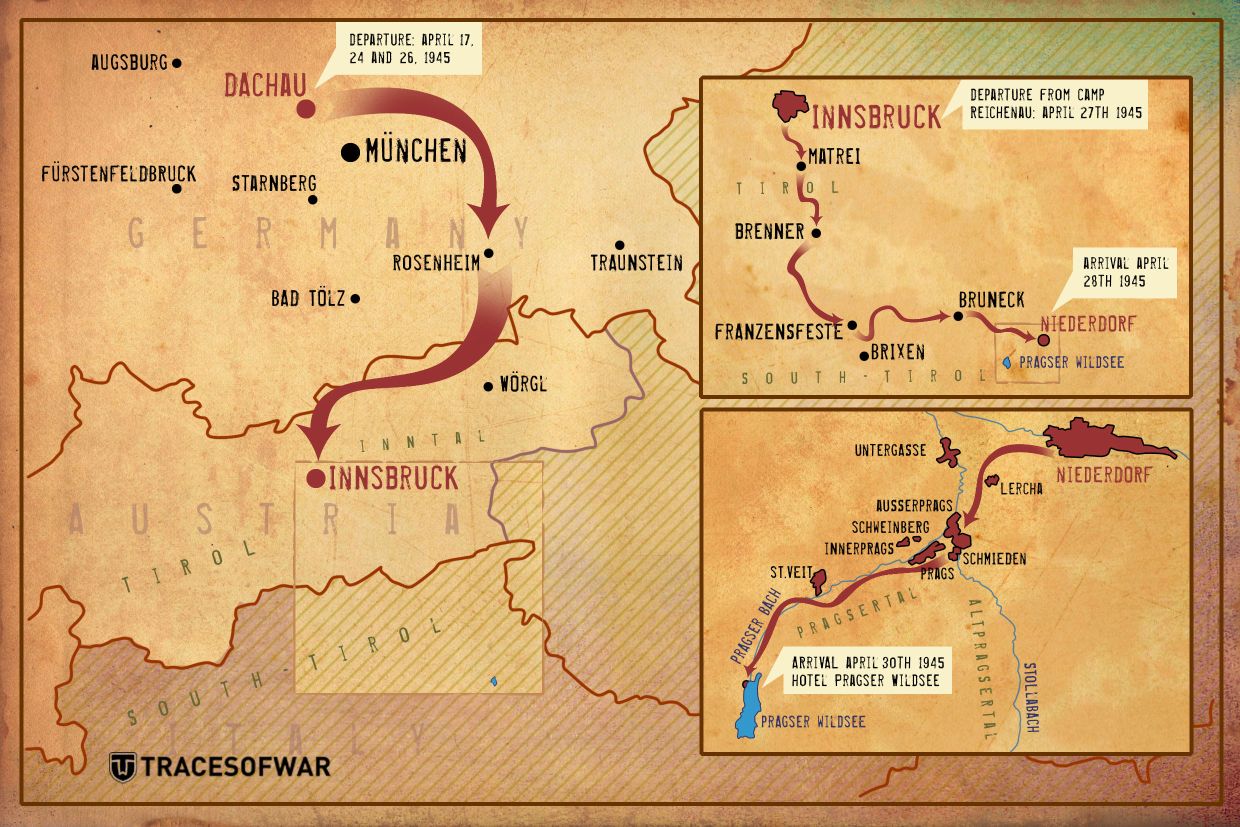 Overview of the route taken by the SS prisoners to Hotel Pragser Wildsee. Source: Roger Paulissen, TracesOfWar.com.
Overview of the route taken by the SS prisoners to Hotel Pragser Wildsee. Source: Roger Paulissen, TracesOfWar.com.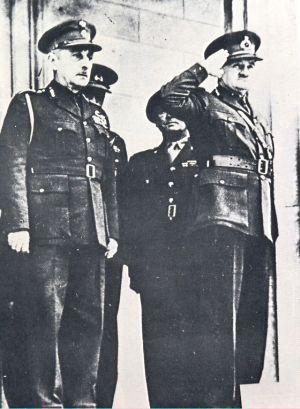 The Greek Commander-in-Chief General Alexandros Papagos (left) with British General Archibald Wavell in Athens, 1941. Source: Athens War Museum / Public domain.
The Greek Commander-in-Chief General Alexandros Papagos (left) with British General Archibald Wavell in Athens, 1941. Source: Athens War Museum / Public domain.At Hotel Pragser Wildsee
Hotel Pragser Wildsee
The day before, SS 0fficer Stiller had managed to have Hotel Pragser Wildsee evacuated thanks to the intervention of the quartermaster of the Wehrmacht. The liberated hostages were taken to the hotel at an altitude of 4,910 feet in army trucks. The heavily loaded trucks were hardly able to negotiate the steep and snow covered mountain road. "Half way through the journey, we had to get out and proceed the next 90 minutes on foot," so Isa Vermehren remembered. "We trudged through deep powdery snow which had fallen recently, we were not accustomed to long walks and a little short of breath. Higher and higher up the snow covered mountain we went until we finally approached an armed German soldier standing guard at the entrance of the premises."
The arrival at the hotel, uniquely situated on the bank of the lake of the same name and a view on the 9,220 feet high Mount Seekofel must have been overwhelming for the hostages. There was one problem though, the hotel opened only in summer. Nonetheless, hotel owner Emma Heiss-Hellenstainer welcomed her unexpected guests with open arms.
Semolina soup
"The benevolent owner of Hotel Pragser Wildsee had declared herself willing to put her large building immediately at the disposal of our group, which had arrived here in such a strange way, " so Isa Vermehren recounted. "She apologized because it was a summer hotel only, hence she was not able to protect us from the prevalent cold but she would do everything possible to make us feel comfortable." In the preparation of quarters, the landlady was assisted by Fregattenkapitän Franz Liedig who had been arrested in November 1944 on suspicion of involvement in the conspiracy against Hitler. Together they allocated rooms, placing equal nationalities together as much as possible and families with children were allocated a room with a stove.
While in other times the menu contained culinary goodies, the first day the hotel guests had to make do with semolina soup, made of a small bag of semolina the hostages had taken with them from Dachau. With their bowls and spoons, they queued up when the soup was distributed, just like in the camp. "They found the soup delicious," the landlady declared "and they were glad to sleep in a real bed at last." The locals came to their aid again providing food and clothing to the hotel guests.
The little League of Nations
The particular location of the hotel had a healing effect on the mood of the men and women who had endured so much in the previous period. Fey von Hassell called the place a "paradise on earth". The atmosphere among the VIPs of 17 nationalities was extremely well. They handled each other so respectfully, causing Isa Vermehren later on to call the group a "little League of Nations." On May 1, 1945, a religious service was held in the characteristic house chapel of the Hellenstainer family, close to the hotel where the hostages expressed their gratitude for their rescue.
The Americans
Despite the idyllic surroundings, danger still loomed for the liberated hostages. In order to protect them against deserted German soldiers who had started pillaging and Italian partisans, Gebhart von Alvensleben, a cousin of Wichard von Alvensleben and who happened to be around, was charged with guarding the hotel. He had 80 soldiers under his command who were billeted in Toblach. Incidents though did not occur. On May 2, the Wehrmacht in Italy surrendered and on May 4, some 170 American soldiers of the 85th Division, 5th Army commanded by Captain John Atwell reached hotel Pragser Wildsee. They arrested the Germans but not before Best had thanked both Wichard and Gebhart von Alvensleben for their gallant attitude and had spoken to the Americans in their benefit.
In the last days at the hotel, the hostages were under American supervision. They had no shortages whatsoever because the Americans had brought along sufficient food, clothing and medicine. The guests were flooded with cigarettes and chocolate. A short time after the Americans, the international press turned up as well and conveyed the remarkable story of the hostages to the world.
After the war
At the end of a stay of more than a week in the hotel, the international company was transferred by the Americans via Verona to Naples from where most of the non-German VIPs returned to their home country. Although the Germans also hoped for a speedy return to the Heimat, they were housed first in Hotel Paradiso Eden in Anacapri on the island of Capri. There they were subjected to a thorough investigation by the Americans into a possible Nazi past. The German service men were transferred to a military prison in Germany as prisoners-of-war.
Various Germans from the group of hostages would later be prosecuted for their role in the Third Reich, including Hjalmar Schacht who was acquitted of all charges against him by the International Military Tribunal in Nuremberg. (See: Final statement Schacht and Verdict Schacht). SS-Obersturmbannführer Stiller, the leader of the transport of hostages was arrested after the war and was released from American imprisonment in 1951.
After the war, a number of non-German hostages played an important role in their country again. León Blum was chairman of the provisional French government from 1946 to 1947 and Alexandros Papagos was Prime Minister of Greece from November 19, 1952 until his death on October 4, 1955. The only Dutch former hostage, former Secretary of Defense Jannes Johannes Cornelis van Dijk did not return to politics.
Reunion
In 2005, a reunion was held in the chapel near Hotel Pragser Wildsee for the former hostages still alive. A monument was unveiled with the names of all hostages who had been received in the hotel on April 30, 1945.
Definitielijst
- League of Nations
- International league of Nations for cooperation and security (1920 – 1941). The League was located in Geneva, in neutral Switzerland. During the 1930s the league of nations could do little against aggressive behaviour of Japan, Manchuria, Italy, Abyssinia and Hitler. The league of nations was in fact the predecessor of the United Nations.
- Nazi
- Abbreviation of a national socialist.
- Wehrmacht
- German armed military forces, divided in ground forces, air force and navy.
Images
Information
- Article by:
- Kevin Prenger
- Translated by:
- Arnold Palthe
- Published on:
- 05-05-2017
- Last edit on:
- 02-05-2020
- Feedback?
- Send it!
